Tocino has always been my ultimate comfort breakfast. And like many, I was obsessed with Pampanga's Best tocino.
But when I learned how to make this homemade Chicken Tocino version, it became a game-changer in my kitchen.
The sweet-savory marinade, enhanced with pineapple juice's natural tenderizing magic and that signature banana ketchup touch, creates a healthier twist that my family actually prefers over the store-bought pork version.
Plus, you'll love knowing exactly what goes into your family's favorite breakfast meat. It's the perfect way to recreate that classic Filipino silog experience at home, complete with all those beautiful caramelized edges that we all fight over at the breakfast table.
Jump to:
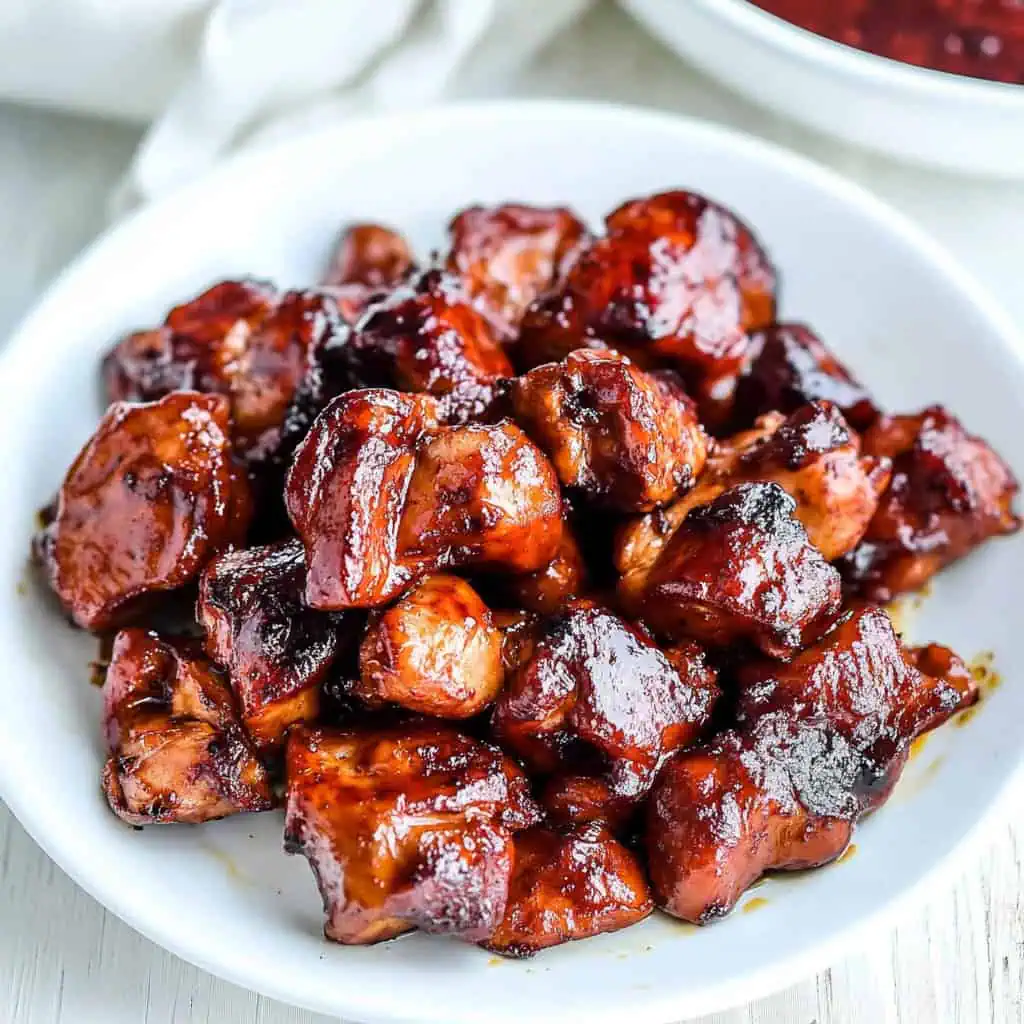
Why You'll Love This Recipe
- Perfect balance of sweet, savory, and garlicky flavors
- Healthier alternative to traditional pork tocino
- Make-ahead friendly – perfect for meal prep
- No artificial preservatives or food coloring
- Restaurant-quality dish made right at home
- Kid-friendly breakfast option
- Budget-friendly protein choice
Ingredients
Each ingredient in this recipe serves a specific purpose to create authentic tocino flavor. Chicken thighs provide juiciness and better flavor absorption than leaner cuts. Pineapple juice naturally tenderizes the meat with its enzymes while adding sweetness.
Banana ketchup contributes the distinctive reddish color and unique Filipino flavor profile. Sugar creates the signature caramelization and sweet notes, while garlic powder and salt balance the sweetness with savory depth.
This careful combination delivers authentic tocino taste without artificial preservatives or food coloring.
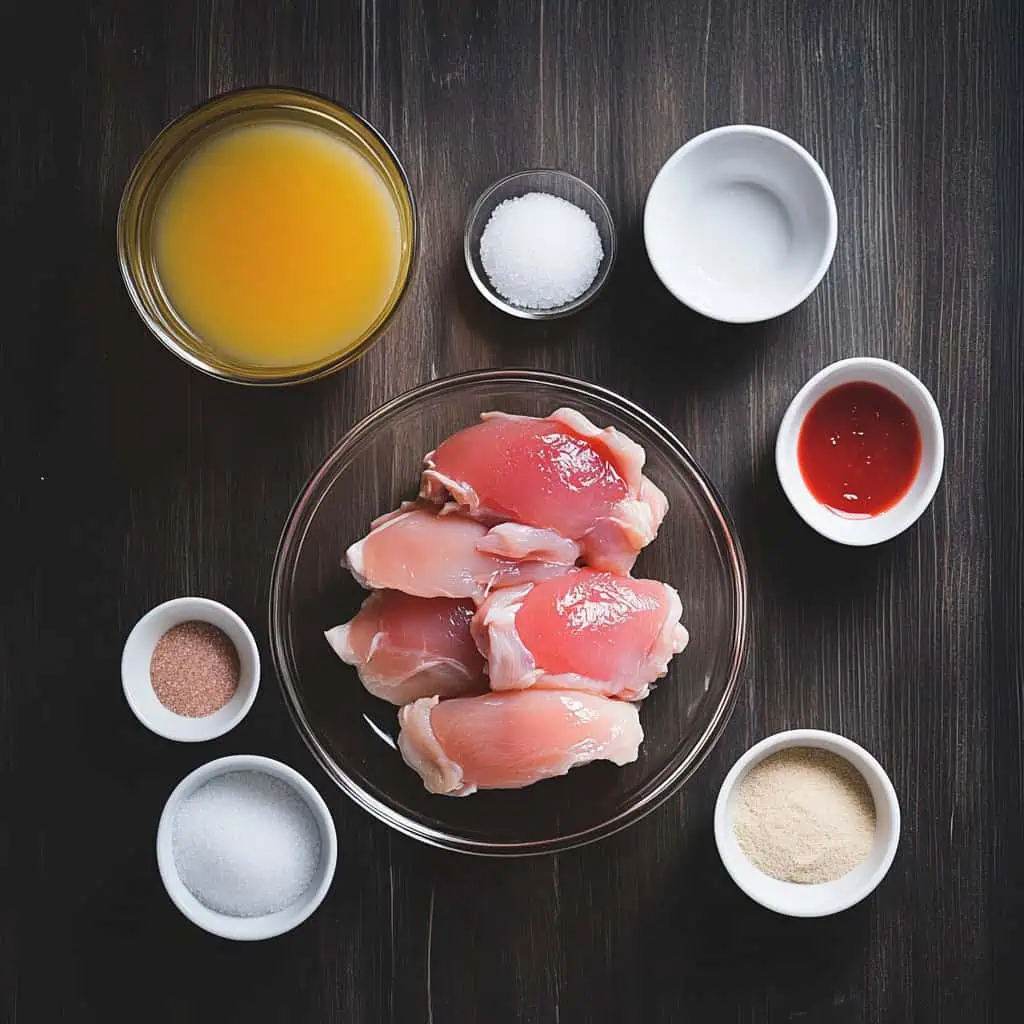
For the Meat:
- 2 pounds chicken thigh or leg meat, boneless and skinless
For the Marinade:
- 1 cup pineapple juice
- ¼ cup banana ketchup
- ½ cup sugar
- 1 tablespoon garlic powder
- 1 tablespoon salt
For Cooking:
- 1 cup water
- 2 tablespoons cooking oil
Equipment
- Large mixing bowl - For combining and thoroughly mixing all the marinade ingredients with the chicken.
- Meat mallet - Essential for tenderizing the chicken pieces, ensuring they cook evenly and absorb the marinade better.
- Sharp knife - Needed for slicing the chicken into the proper thickness for authentic tocino.
- Heavy-bottom skillet or pan - Provides even heat distribution, crucial for achieving the perfect caramelization without burning.
- Measuring cups and spoons - For accurate measurements of ingredients to achieve the perfect flavor balance.
- Food storage containers - For safely storing the chicken while it marinates in the refrigerator.
- Kitchen tongs - Makes handling the chicken pieces while cooking easier and safer.
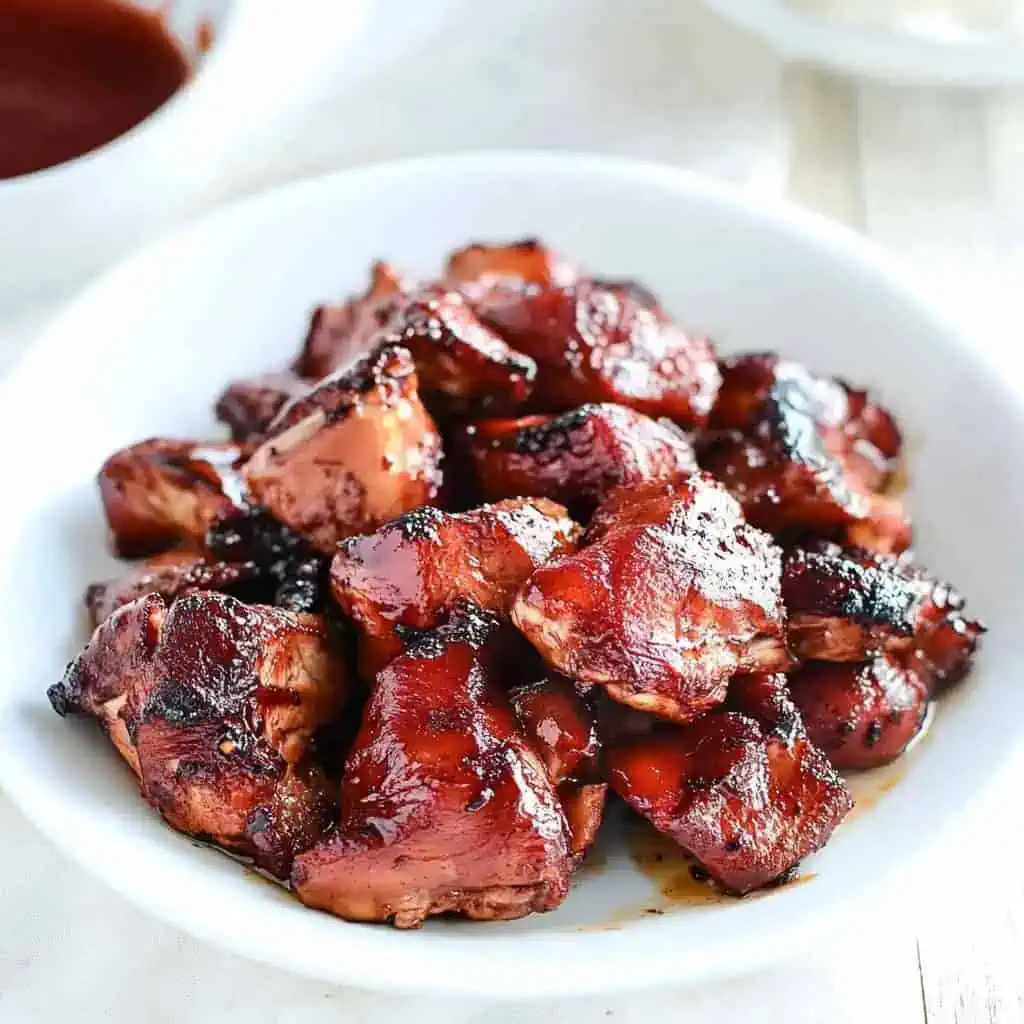
How To Make
- Cut the chicken thighs into thin, bite-sized pieces about ½-inch thick.
- Mix pineapple juice, banana ketchup, sugar, garlic powder, and salt in a bowl until sugar dissolves completely.
- Add chicken pieces to the marinade and mix well, making sure each piece is coated. Place in a container and refrigerate for 4-8 hours.
- Remove marinated chicken from the refrigerator 15 minutes before cooking.
- Place chicken and marinade in a pan over medium heat. Add 1 cup water and bring to a boil.
- Lower heat, cover the pan, and simmer for 15-20 minutes until chicken is tender.
- Once liquid is mostly absorbed, add cooking oil and increase heat to medium-high.
- Cook for 5-7 minutes, turning chicken pieces occasionally, until they turn golden brown and slightly charred.
- Turn off heat and let rest for 2-3 minutes before serving.
- Serve hot with garlic rice and sunny-side-up egg for a complete breakfast meal.
Note: Don't marinate longer than overnight as the pineapple juice can make the chicken too soft.

Tips from Lola's Kitchen
- Choose the right cut: Always use chicken thighs instead of breast for juicier, more flavorful tocino.
- Proper pounding technique: Don't skip the meat pounding step – it helps tenderize and ensures even cooking and marinade absorption.
- Natural tenderizing: The enzymes in pineapple juice (called bromelain) break down protein fibers, naturally tenderizing the meat.
- Cook in batches: Avoid overcrowding the pan – this ensures even caramelization on all pieces.
- Rest before cooking: Allow meat to rest at room temperature for 15 minutes before cooking to promote even cooking.
- Use the marinade wisely: Save some marinade for basting during cooking to enhance flavor and caramelization.
- Watch the heat: Cook on medium heat first to ensure the chicken cooks through, then increase to medium-high at the end for caramelization.
- Look for the sizzle: When the sugars start to caramelize, you'll hear a distinctive sizzling sound – this is when you know the magic is happening.
Substitutions
- Pineapple juice: Sprite or 7-Up can work as substitutes, providing sweetness and some acidity.
- Banana ketchup: Use regular tomato ketchup plus 1 tablespoon brown sugar for a similar flavor profile.
- Sugar: Brown sugar provides a deeper molasses flavor, or honey can be used for a different sweetness profile.
- Garlic powder: Fresh minced garlic (3 cloves) adds a more pronounced garlic flavor.
- Chicken thighs: While not recommended, chicken breast can be used if thoroughly tenderized and carefully monitored during cooking to prevent drying out.
Troubleshooting
Too Sweet:
- Reduce sugar in the next batch of marinade
- Add a splash of vinegar or lemon juice to balance sweetness
- Serve with something acidic like pickled papaya (atchara) to cut through the sweetness
Too Dry:
- Use lower heat and check for doneness earlier
- Make sure to use chicken thighs, not breast meat
- Don't cook beyond the recommended time
- Add a little more oil during the final cooking stage
Not Caramelizing:
- Ensure your pan is hot enough during the final cooking stage
- Remove excess liquid before the caramelization step
- Make sure there's enough sugar in the marinade
- Use a heavy-bottomed pan for better heat distribution
Too Salty:
- Add more water during the simmering stage
- Balance with a bit more sugar in the cooking process
- Serve with plain rice rather than garlic rice
Meat Too Soft/Mushy:
- Don't marinate for more than 12 hours
- Reduce the amount of pineapple juice in the marinade
- Make sure to use fresh (not previously frozen and thawed) chicken
Storage & Reheating
Refrigerator Storage:
- Store in an airtight container for 3-4 days
- Keep marinade and meat together if storing uncooked
- Separate cooked tocino from any excess oil before storing
Freezer Storage:
- Uncooked marinated chicken: Up to 6 months in freezer bags
- Cooked chicken tocino: Up to 2 months
- Freeze in portion sizes for easier thawing and reheating
Reheating Methods:
Stovetop (Best Method):
- Add a splash of water to a pan
- Heat on medium for 5-7 minutes
- Add a teaspoon of oil toward the end for re-caramelization
Microwave:
- Cover with a damp paper towel to prevent drying out
- Heat for 1-2 minutes, checking halfway through
- Let rest for 1 minute before serving
Oven:
- Preheat to 350°F (175°C)
- Cover with foil to prevent drying
- Heat for 10-15 minutes until warmed through
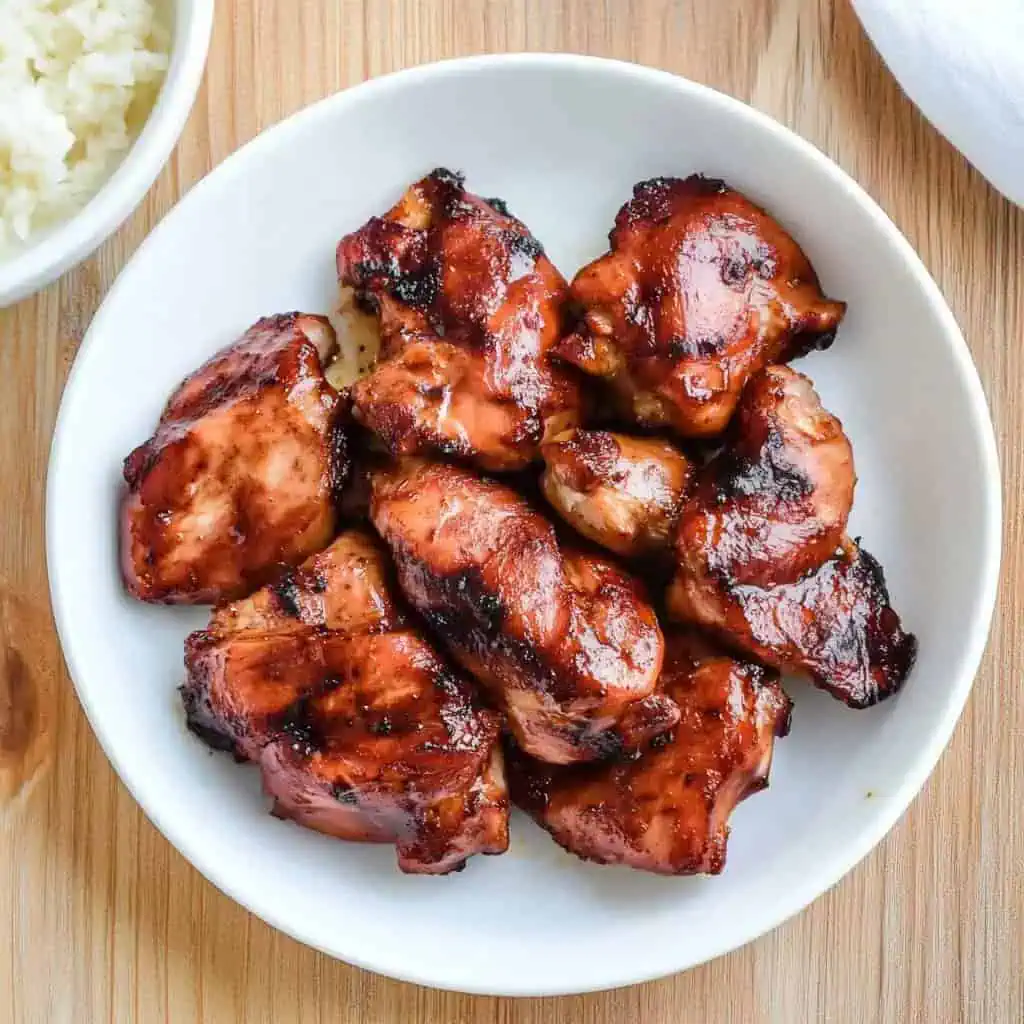
FAQ
Can I use chicken breast instead of thighs?
While you can use chicken breast, thigh meat is strongly recommended for better flavor, moisture, and authentic texture. If using breast meat, don't skip the tenderizing step and be very careful not to overcook.
Why shouldn't I marinate longer than overnight?
The enzymes in pineapple juice continue to break down the meat proteins even in cold temperatures. Marinating too long can turn the meat mushy rather than tender.
Can I freeze the marinated chicken?
Yes! You can freeze the chicken in its marinade for up to 6 months in airtight freezer bags. Thaw completely in the refrigerator before cooking.
How do I know when the chicken tocino is done cooking?
The internal temperature should reach 165°F (74°C), and the meat should have caramelized edges with a sticky, glazed appearance. The sauce will also thicken considerably.
Can I make this in advance for a brunch party?
Absolutely! You have two options: marinate up to 8 hours ahead and cook fresh before serving, or fully cook the tocino up to 2 days ahead and reheat just before serving.
Is tocino supposed to be very sweet?
Yes, traditional tocino has a distinctly sweet profile balanced with savory and garlicky notes. If you prefer less sweetness, you can reduce the sugar in the recipe.
Why is my tocino not turning red like store-bought versions?
Commercial tocino often contains food coloring. This homemade version relies on natural color from banana ketchup, which gives a more subtle reddish-brown hue when caramelized.
Can I use this same recipe for pork tocino?
Yes! Use pork shoulder (kasim) or pork belly, sliced thinly. The marination and cooking process remains the same, though cooking time may vary slightly.
Related
Looking for other recipes like this? Try these:

Authentic Filipino Chicken Tocino Recipe (Manok na Tocino)
Equipment
- Large mixing bowl (Malaking mangkok) for marinating
- Meat mallet (Pamukpok ng karne) for tenderizing chicken
- Sharp knife [Matalas na kutsilyo] for slicing meat
- Heavy-bottom skillet or pan (Kaserola) for even heating and caramelization
- Measuring cups and spoons (Panukat) for accurate measurements
- Food storage containers (Lalagyan) for marinating
- Kitchen tongs (Sipit) for handling meat while cooking
Ingredients
For the Meat:
- 2 pounds 1 kg chicken thigh or leg meat, boneless and skinless (Manok na hita o paa)
- Choose thigh meat for best results as it stays juicier
For the Marinade:
- 1 cup pineapple juice Katas ng pinya
- ¼ cup banana ketchup Banana catsup
- ½ cup sugar Asukal
- 1 tablespoon garlic powder Pulbos na bawang
- 1 tablespoon salt Asin
For Cooking:
- 1 cup water Tubig
- 2 tablespoons cooking oil Mantika
Instructions
- Cut the chicken thighs into thin, bite-sized pieces about ½-inch thick.
- Mix pineapple juice, banana ketchup, sugar, garlic powder, and salt in a bowl until sugar dissolves completely.
- Add chicken pieces to the marinade and mix well, making sure each piece is coated. Place in a container and refrigerate for 4-8 hours.
- Remove marinated chicken from the refrigerator 15 minutes before cooking.
- Place chicken and marinade in a pan over medium heat. Add 1 cup water and bring to a boil.
- Lower heat, cover the pan, and simmer for 15-20 minutes until chicken is tender.
- Once liquid is mostly absorbed, add cooking oil and increase heat to medium-high.
- Cook for 5-7 minutes, turning chicken pieces occasionally, until they turn golden brown and slightly charred.
- Turn off heat and let rest for 2-3 minutes before serving.
- Serve hot with garlic rice and sunny-side-up egg for a complete breakfast meal.
- Note: Don't marinate longer than overnight as the pineapple juice can make the chicken too soft.
Tips from Lola's Kitchen
- Use chicken thighs instead of breast for juicier results
- Don't skip the meat pounding step – it helps tenderize and ensure even cooking
- The natural enzymes in pineapple juice help tenderize the meat
- Cook in batches to avoid overcrowding the pan
- Allow meat to rest at room temperature for 15 minutes before cooking
- Save the marinade for basting during cooking
Nutrition
The Story Behind Chicken Tocino
Growing up in the culinary capital of the Philippines, Pampanga, I learned that tocino holds a special place in Filipino food history. While many assume it's purely Filipino, this beloved breakfast meat actually traces its roots to the Spanish colonial period, when Spanish colonizers introduced the art of curing meat to our islands. The word "tocino" itself comes from Spanish, originally referring to bacon or cured pork belly, but Filipinos transformed it into something uniquely our own.
What makes Filipino tocino distinct is our ingenious addition of sweetness to the curing process. This sweet-and-savory profile became so popular that it evolved beyond just pork, with chicken tocino emerging as a healthier alternative in the 1980s. Pampanga, known as the country's culinary capital, particularly embraced this innovation, leading to famous brands like Pampanga's Bestt pioneering commercially-available tocino that would later become a household name across the Philippines.
Today, chicken tocino has earned its place as a healthier yet equally delicious alternative to traditional pork tocino. It's become a staple in modern Filipino households, especially for health-conscious families who still crave that signature tocino taste. The evolution of this dish perfectly represents how Filipino cuisine continues to adapt while maintaining its cultural identity – taking inspiration from our colonial past but adding our own distinctive sweet and garlicky twist that makes it uniquely Pinoy.
The real beauty of homemade chicken tocino lies in its simplicity and the control you have over its ingredients. Unlike commercial versions that often contain preservatives and artificial coloring, this recipe stays true to the essential flavors while incorporating natural ingredients like pineapple juice, which not only adds sweetness but also helps tenderize the meat. This combination of traditional technique with modern, healthier ingredients showcases how Filipino cuisine continues to evolve while honoring its rich culinary heritage.
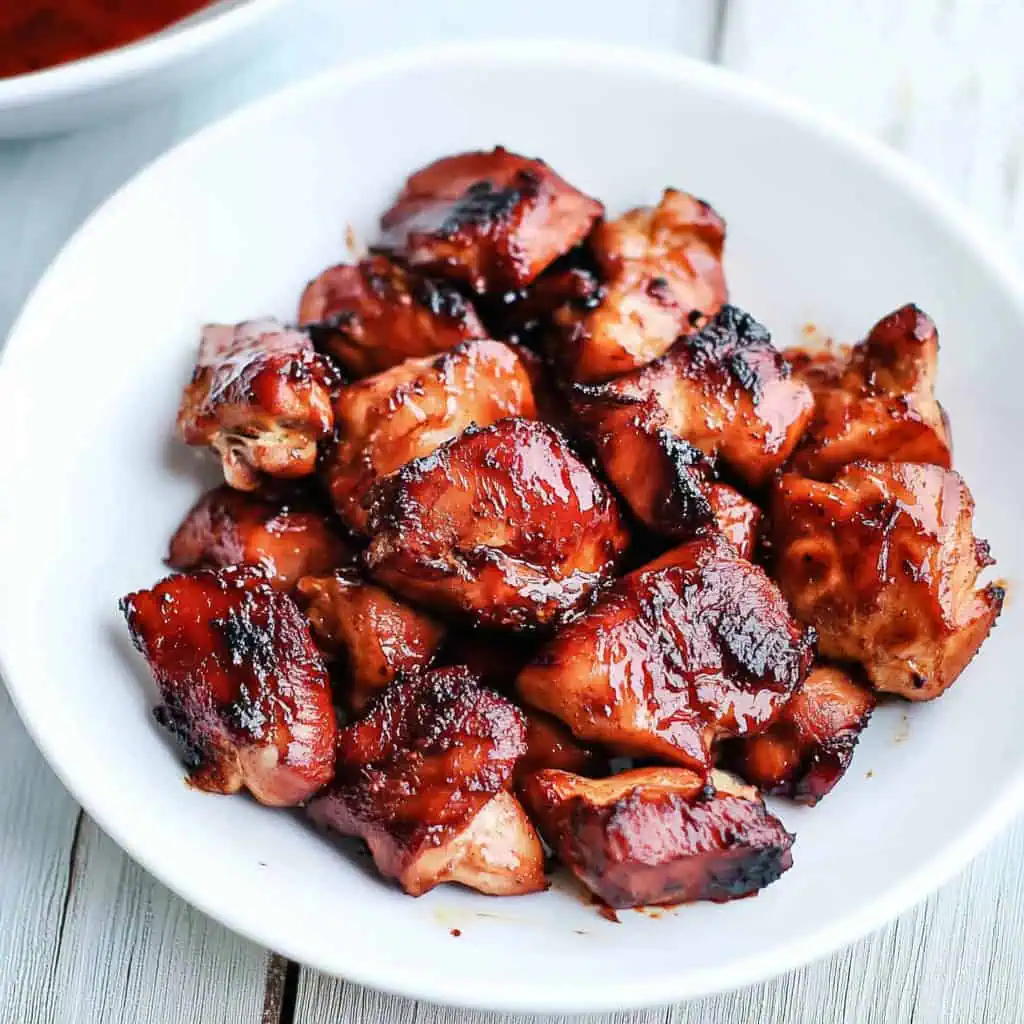









Comments
No Comments